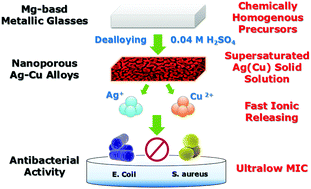Design and preparation of nanoporous Ag–Cu alloys by dealloying Mg–(Ag,Cu)–Y metallic glasses for antibacterial applications
Abstract
Three-dimensional nanoporous Ag–Cu alloys with an atomic ratio of Ag to Cu varying from 0 to 1.0 were fabricated by dealloying Mg–(Ag,Cu)–Y metallic glass precursors in 0.04 M H2SO4 aqueous solution. Supersaturated Ag(Cu) solid solution in the nanoporous structure was obtained with a high Cu concentration (up to 47.4%) in the fcc Ag phase after the dealloying treatment. The nanoporous alloys with an ultrafine ligament size (down to 20 nm), a large specific surface area (up to 11.18 m2 g−1) and high oxidation resistance in air atmosphere were employed for inhibiting the growth of Gram-negative E. coli and Gram-positive S. aureus. In vitro characterization reveals that the nanoporous alloy with an Ag/Cu ratio of 1 : 1 exhibited the best antibacterial activities in terms of both ultralow minimal inhibitory concentration (MIC) (down to 3 and 2.5 mg L−1 for S. aureus and E. coli) and long-term inhibition on bacterial growth in the group of the tested materials. A highly efficient and sustainable release of Cu ions from the nanoporous Ag–Cu alloy could be responsible for such excellent antibacterial activities.



 Please wait while we load your content...
Please wait while we load your content...